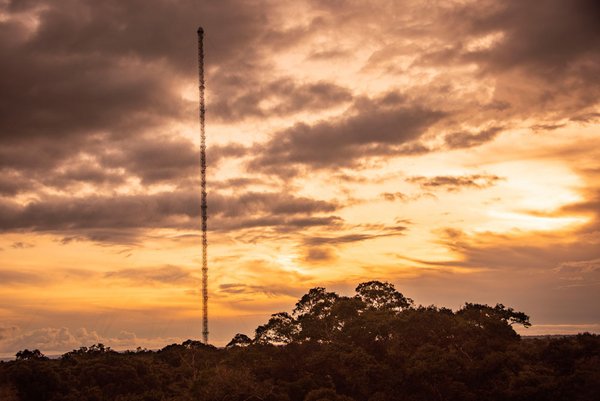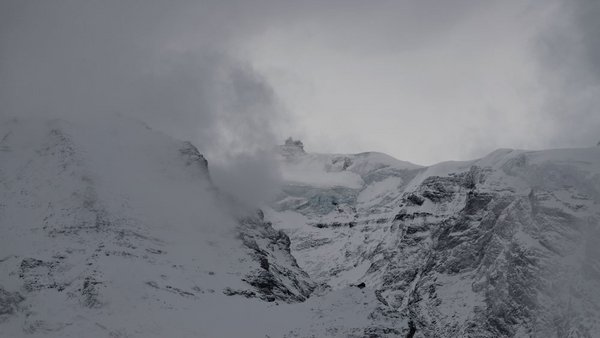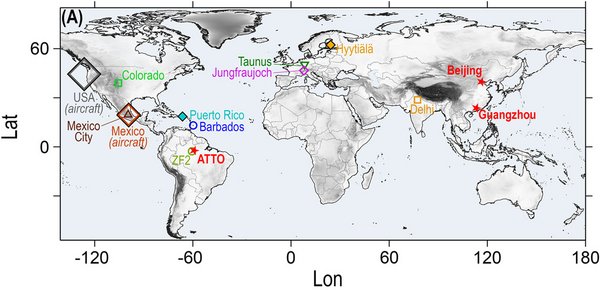Effect of aerosol particles on clouds and the climate captured better
Leipzig,
21.11.2023
Global measurements and model calculations show that the complex relationship between the chemistry and climate impact of aerosol particles can be successfully captured by a simple formula.
Leipzig/Mainz. The extent to which aerosol particles affect the climate depends on how much water the particles can hold in the atmosphere. The capacity to hold water is referred to as hygroscopicity (K) and, in turn, depends on further factors – particularly the size and chemical composition of the particles, which can be extremely variable and complex. Through extensive investigations, an international research team under the leadership of the Max Planck Institute for Chemistry (MPIC) and the Leibniz Institute for Tropospheric Research (TROPOS) was able to reduce the relationship between the chemical composition and the hygroscopicity of aerosol particles to a simple linear formula. In a study that appeared in the journal "Nature Communications", they showed that hygroscopicity, averaged globally, is essentially determined by the share of organic and inorganic materials making up the aerosol.
The hygroscopicity of aerosol particles is an important factor in the effect of aerosol particles on the climate and thus also for forecasting changes to the climate using global climate models. "The capacity to hold water depends on the composition of aerosol particles, which can vary considerably in the atmosphere. However, in our study we were able to show that simplified assumptions can be made for the consideration of hygroscopicity in climate models," explains Mira Pöhlker. She is in charge of the "Atmospheric Microphysics" department at TROPOS and is a professor at the University of Leipzig. According to the aerosol and cloud researcher, this is the first study to use measurement results from across the world to show that a simple linear formula can be used without creating huge uncertainty in climate models.
For this purpose, Mira Pöhlker's team evaluated data from 16 measurement campaigns between 2004 and 2020, in which hygroscopicity was determined by means of cloud condensation nuclei measurements and the chemical composition of particles by means of aerosol mass spectrometry. The extensive data covered a wide range of Earth's regions and climate zones: From the Amazon's tropical rainforest through metropolitan regions with significant air pollution in Asia to the boreal pine forest of the Arctic Circle in Europe.
The evaluation of these data sets revealed: Effective aerosol hygroscopicity (κ) can be derived from the share of organic materials (ϵorg) and inorganic ions (ϵinorg) using a simple linear formula (κ = ϵorg ⋅ κorg + ϵinorg ⋅ κinorg). "Despite the chemical complexity of the organic matter, its hygroscopicity is successfully captured by the simple formula," explains Christopher Pöhlker, Group Leader at the Max Planck Institute for Chemistry and co-author of the study. When averaged globally, he reports, hygroscopicity is κorg= 0.12 ± 0.02 for organic particle shares and κinorg = 0.63 ± 0.01 for inorganic ions.
Effect of the new formula on climate forecasts
To test the new formula, the researchers used the global aerosol climate model ECHAM-HAM. "In our study, we were able to use experiments to show that simplified assumptions can be made in this area without causing great uncertainty in the model results. This means that investigations and forecasts relating to climate change are more reliable," Mira Pöhlker says in summary. "Our study was enabled by measurement campaigns with international partners at a wide variety of locations worldwide as well as by long-term observations at particular research stations, such as the ATTO observatory in the Brazilian rainforest," reports Christopher Pöhlker from the Max Planck Institute for Chemistry in Mainz.
Scientific background:
The interactions of atmospheric aerosols with solar radiation and clouds continue to be inadequately understood and are among the greatest uncertainties in the model description and forecasting of changes to the climate. One reason for this is the many unanswered questions around the hygroscopicity of aerosol particles. Depending on size and chemical composition, tiny aerosol particles can hold different amounts of water. This is important both for the scattering of solar radiation by the aerosol particles themselves as well as for the formation of cloud droplets. Particles that hold more water scatter more sunlight back into the universe and can also have a cooling effect through the formation of more cloud droplets.
Publication:
Mira L. Pöhlker, Christopher Pöhlker, Johannes Quaas, Johannes Mülmenstädt, Andrea Pozzer, Meinrat O. Andreae, Paulo Artaxo, Karoline Block, Hugh Coe, Barbara Ervens, Peter Gallimore, Cassandra J. Gaston, Sachin S. Gunthe , Silvia Henning, Hartmut Herrmann, Ovid O. Krüger, Gordon McFiggans, Laurent Poulain, Subha S. Raj, Ernesto Reyes-Villegas, Haley M. Royer, David Walter, Yuan Wang, Ulrich Pöschl: Global organic and inorganic aerosol hygroscopicity and its effect on radiative forcing. Nat Commun 14, 6139 (2023).
https://doi.org/10.1038/s41467-023-41695-8
The research was funded by: Deutsches Klimarechenzentrum (DKRZ; project ID bb1036), Max Planck Society (MPG), Bundesministerium für Bildung und Forschung (BMBF contracts 01LB1001A, 01LK1602B, and 01LK2101B (ATTO project)), European Union’s Horizon 2020 research and innovation programme (grant No 821205 (FORCES)), French National Research Agency (grant no. ANR-17-MPGA-0013), NERC & Newton Fund through (grant ref. NE/P016480/1 (PROMOTE project of APHH-Delhi programme).
Media contacts:
Prof. Dr Mira Pöhlker,
Head of the Atmospheric Microphysics Department (AMP), Leibniz Institute for Tropospheric Research (TROPOS) and Leipzig University,
Phone +49 341 2717-7431
https://www.tropos.de/institut/ueber-uns/mitarbeitende/mira-poehlker
and
Dr. Christopher Pöhlker,
Group Leader, Multiphase Chemistry, Max Planck Institute for Chemistry (MPIC), Mainz,
Phone +49-6131-305-7800
https://www.mpic.de/4493431/christopher-poehlker
and
Prof. Dr. Johannes Quaas,
Professor for Theoretical Meteorology, Leipzig University;
Tel. +49-341-97-32931
https://www.uni-leipzig.de/en/profile/mitarbeiter/prof-dr-johannes-quaas
oder
Tilo Arnhold, Public Relations, Leibniz Institute for Tropospheric Research (TROPOS), Leipzig,
Phone +49-341-2717-7189
http://www.tropos.de/aktuelles/pressemitteilungen/
und
Anne Reuter, Kommunication, Max Planck Institute for Chemistry (MPIC), Mainz;
Phone +49-6131-305-3003
https://www.mpic.de/3477744/press-releases
und
Media Team, Office for University Communications, Leipzig University;
Phone +49-341-97-35025
https://www.uni-leipzig.de/en/universitaet/service/media-and-communications?pk_campaign=zielgruppeneinstieg
Measurement campaigns included in the study:
- ATTO 2014-2015 (tropical rainforest in Brazil)
- PRIDE-PRD2006 (Guangzhou: rural environment of a megacity in China)
- CAREBeijing-2006 (Beijing: suburb of a megacity in China)
- Delhi-2018 (New Delhi: severe air pollution in India)
- BACO-2020 (Barbados: clean sea air with long-distance transport from Africa)
- PRACS-2004 (Puerto Rico: clean marine air with some air pollution)
- FACE-2005 (Feldberg in Taunus: rural background in Germany)
- CLACE-2006 (Jungfraujoch: high alpine in Switzerland)
- AMAZE-08 (tropical rainforest in Brazil)
- EUCAARRI-2007 & 2009-2012 (Hyytiälä: boreal forest in Finland)
- MIRAGE-2006 (aircraft measurements over Mexico)
- MILAGRO-2006 (Mexico City: megacity in Mexico)
- INTEX-B-2006 (aircraft measurements over the USA)
- Taunus-Observatory-2012 (rural background in Germany)
- BEACHON-2010-2011 (Colorado: semi-arid mountain forest in the USA)
Further information and links:
Minerva Fast Track Project “Cloud Condensation Nuclei”
https://www.mpic.de/4484428/team-poehlker
CLACE - CLoud and Aerosol Characterization Experiment
https://www.mpic.de/3583800/clace
Lab-studies connecting hygroscopic growth and droplet activation
https://www.tropos.de/en/research/aerosol-cloud-interaction/process-studies-on-small-spatial-and-temporal-scales/aerosol-and-clouds-microphysical-interactions/activation-of-cloud-droplets/lab-studies-connecting-hygroscopic-growth-and-droplet-activation
Process studies of direct and indirect radiative forcing
https://www.tropos.de/en/institute/departments/experimental-aerosol-and-cloud-microphysics/tropospheric-aerosols-workgroup/process-studies-of-direct-and-indirect-radiative-forcing
The Leibniz Institute for Tropospheric Research (TROPOS) is a member of the Leibniz Association, which connects 97 independent research institutions that range in focus from the natural, engineering and environmental sciences via economics, spatial and social sciences to the humanities. Leibniz Institutes address issues of social, economic and ecological relevance. They conduct knowledge-driven and applied basic research, maintain scientific infrastructure and provide research-based services.
The Leibniz Association identifies focus areas for knowledge transfer to policy-makers, academia, business and the public. Leibniz institutions collaborate intensively with universities – in the form of “Leibniz ScienceCampi” (thematic partnerships between university and non-university research institutes), for example – as well as with industry and other partners at home and abroad.
They are subject to an independent evaluation procedure that is unparalleled in its transparency. Due to the importance of the institutions for the country as a whole, they are funded jointly by the Federation and the Länder, employing some 20,500 individuals, including 11,500 researchers.
The entire budget of all the institutes is approximately 2 billion euros. They are financed jointly by the Federal Government and the Länder. The basic funding of the Leibniz Institute for Tropospheric Research (TROPOS) is therefore financed by the Federal Ministry of Education and Research (BMBF) and the Saxon State Ministry of Science and the Arts (SMWK). The Institute is co-financed with tax revenues on the basis of the budget approved by the Saxon State Parliament.
https://www.leibniz-gemeinschaft.de/en/home/
https://www.bmbf.de/en/index.html
https://www.smwk.sachsen.de/



